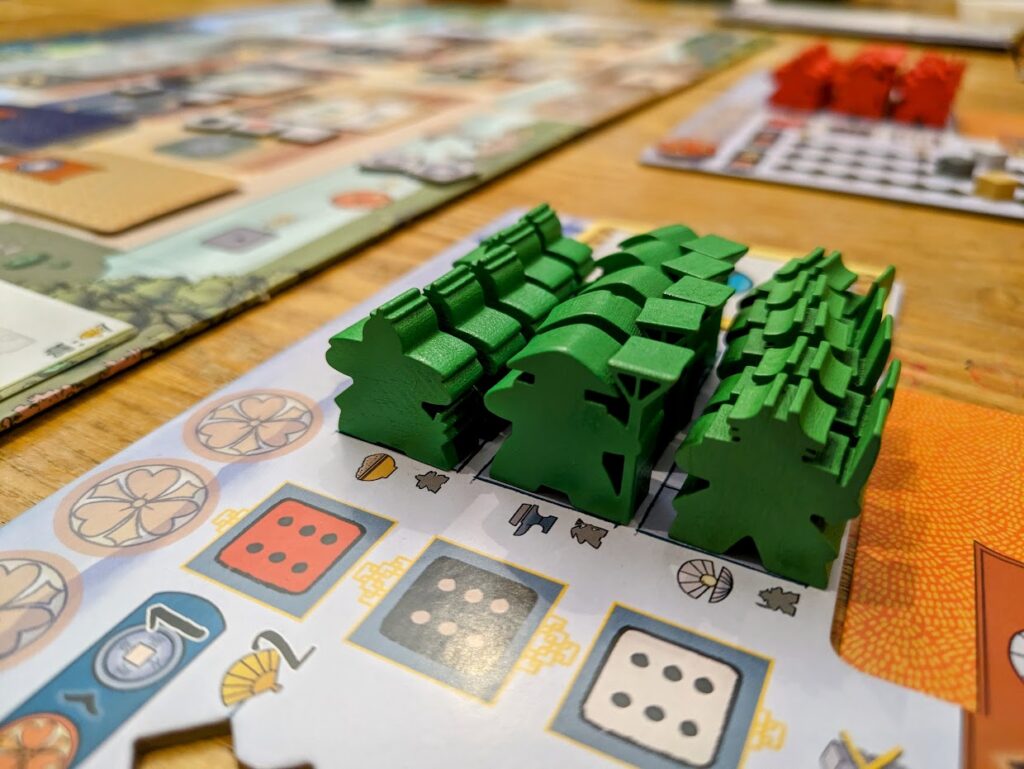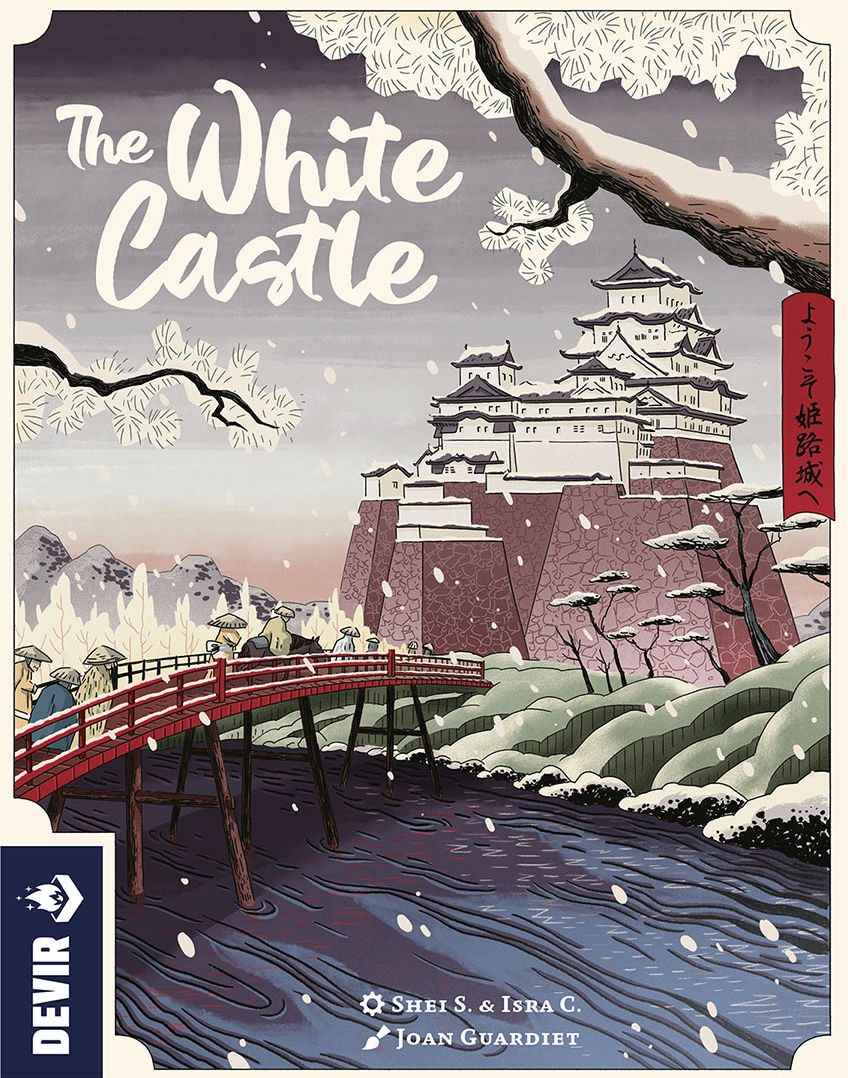The duo behind Llama Dice are back with another colour + building game, following on from 2020’s The Red Cathedral, which I loved. You can read that review right here. The White Castle continues the idea of putting a clever, think Euro game in a dinky little box, but changes things considerably. It’s a dice-as-workers game, which is a mechanism I really enjoy, but in opposition to games like Pingyao: First Chinese Banks, or Wayfarers of the South Tigris, The White Castle is tight. It’s also very, very good.
Chain reaction
Playing The White Castle is easy in principle. Grab a die from either end of one of the three bridges on the board. Place that die in a colour-matched worker space, and take that action. If the value of the die is below the value printed on the board you pay the difference. If the value is higher, take the difference in money from the bank.

It doesn’t sound difficult when you put it like that, and in all honesty, it isn’t. There are only a few areas on the board to place the dice, along with a few on your own player board. The kicker though, and the first thing you’ll hear from anyone who’s played it, is that you only get nine turns for the entire game.
That’s right, nine turns.
Three dice in the first round, three in the second, and three in the third and final round. If it sounds like that’s barely enough turns to get a strategy together, then you’re right, and your first couple of games have a real feeling of “What? That’s it? Oh…”.
There are plenty of people who will call the game right there. Played it, it ended too quickly, sell it on Facebook. And that’s fair. If you’ve got more games than you can play, there’s a perfectly valid argument to get rid of the things you’re not enjoying.
In the case of The White Castle, however, persistence reaps huge rewards. Once you get the hang of creating chained actions, things get spicy.
Nickel-and-Daimio?
Have you ever played a game and used one of your turns with the thought of “Let’s just get some stuff this turn”? Of course you have, we all have. Forget that when you play The White Castle. Go on, just dump it out of your brain. Tell yourself right now – there are NO dead turns in this game. If you’re not doing really productive stuff on every single one of your nine turns, you’re going to do badly.
I’ll give you an example. Taking a die from the left end of a bridge means you’re going to get a lower value. The lowest values go on the left end of a bridge, and the highest go to the right. Taking a die from the left often means you’re going to have to cough up a few coins to take an action, but those left dice also trigger your lantern actions. You might be wondering what lantern actions are. Good. At the bottom of your player board, there’s a space to add action cards you claim from the main board, and these cards stack. Every time you trigger the lantern, you do all of those lantern actions.
Nice, right?

Here’s where it gets tricky. To use lantern actions, you need some action cards. To get lantern cards you need to place courtier meeples into the castle. As they climb through the levels they take the cards and send them back to your board and your lantern area. So how do you get a courtier into the castle? You find a spot where you can place a die to take that action. Spend some mother-of-pearl and up they go.
The astute among you might have noticed I said ‘take that action’ in there, and that’s where the Eureka moment comes from. Or more accurately, the ‘eek!’ moment. Taking one action is 11% of your entire game. ELEVEN PERCENT! That’s a lot. Those first couple of plays will hammer home how much of an efficiency puzzle The White Castle is, and how dynamic it is. The dice in each round are random, as are the actions on the main board, the rewards available in different areas, and of course the biggest random factor of all – other people.
Final thoughts
I feel myself cringing when I start this summary because I need to use a trite, overused line. The White Castle packs a lot of game into a small box. Ugh, there, I said it. It’s true though, Devir and Llama Dice have proven that you don’t have to conform to the Kallax-hugging 30cm x 30cm boxes and fill them with stuff, just to provide a game experience that you’d want to headline a games night with. All credit to them with sticking to their guns when they can, because a small box with a language-agnostic board and cards, combined with packing all the different language rulebooks, means they can keep costs down. I try not to mention the cost of games here, because it varies around the world, and because I try to focus on the game for what it is, rather than providing some kind of cost-benefit analysis.

That said, you can pick up The White Castle for less than thirty quid at the time of writing. That’s a bit of a bargain in my eyes. It doesn’t swamp a table even with four players, and it plays out in less than 90 minutes with those same four players. It scales really well and works as well with two people as it does with four, which again, is something you can’t say about every game being released now. The solo game is clean and easy to run, and a great option when you don’t have somebody else at the table with you.
Most importantly though, The White Castle is fun. It’ll have you scratching your head and it might even leave you feeling frustrated for your first few plays, but it really is worth sticking with. Instead of building a sprawling, multi-armed machine in the way some games do now, you build this small, efficient machine which blinks out of existence as quickly as it comes into being. It’s not the game for you if you’re after a sandbox to play in, but if you want a tight, satisfying puzzle of a Euro, it’s a great choice.
You can buy this game from my retail partner, Kienda. Remember to sign-up for your account at kienda.co.uk/punchboard for a 5% discount on your first order of £60 or more.
Enjoying this article? Consider supporting me.

The White Castle (2023)
Design: Isra C., Shei S.
Publisher: Devir
Art: Joan Guardiet
Players: 1-4
Playing time: 60-90 mins



Thanks for the overview. I have been looking into this one, but mainly for solo play, which I’ve heard described as “unfair” and “frustrating” more than anything else. Perhaps your advice of “there are NO dead turns in this game” could help overcome that.
It’s more a case of – if you have a dead turn where you don’t do much, it can have a big knock-on into the rest of the game. If you can be productive each turn, then you’ll do better.
To be transparent, I only played the solo mode twice, which I enjoyed, but I preferred the multiplayer game.